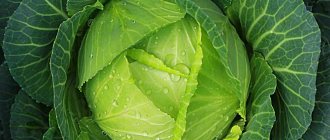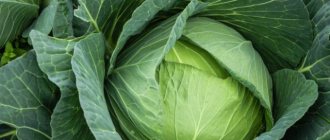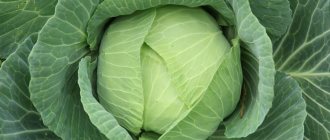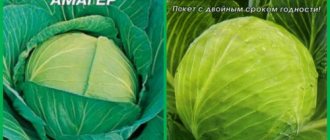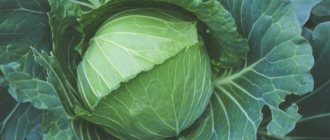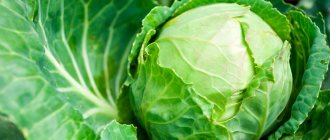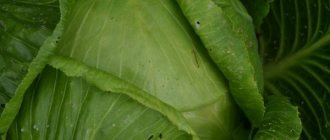Cabbage Vyuga F1 is a relatively new variety that was created by a breeding group at the West Siberian station. Due to its marketability, good preservation and density, vegetable growers cultivate this variety for winter storage and use.
| Landing location | Ripening time | View | Purpose | Origin | Maturation period | Weight |
| Open ground | Late ripening | White cabbage | Long-term storage, fermentation, cooking | Variety | 140-145 | 3,5-5 |
Description of the Vyuga cabbage variety
The variety of white cabbage Vyuga, bred in Siberia, is a universal purpose, medium-late ripening variety intended for industrial and individual cultivation. It is distinguished by its ease of care and high shelf life, for which it is especially valued.
Breeding history
The variety was developed by Siberian breeders at the Federal Scientific Center for Vegetable Growing. It was obtained relatively long ago, in 1983, so it has already become very widespread. In 1989, the culture was included in the State Register of Russia.
Chemical composition and beneficial properties
White cabbage contains vitamins C and U, which have anti-inflammatory, healing and antioxidant properties. In addition to them, the chemical composition includes:
- vitamins K, B1, B2, B3, B4, B5, B6 and B9, beta-carotene;
- macroelements: potassium, calcium, silicon, magnesium, sulfur, phosphorus;
- trace elements: boron, iodine, manganese, chromium and others.
Phytosterols campesterol and brassicasterol reduce the amount of cholesterol absorption in the intestine by 10–20%.
Due to its high sugar content (approximately 5 g per 100 g of leaves), cabbage is ideal for pickling. Increased juiciness makes it indispensable for salads.
Features of application
Vyuga is a universal variety of white cabbage, so it is widely used in cooking:
- for cooking, stewing and frying;
- for fresh salads;
- for canning and fermentation.
The most important and valuable quality of this cabbage is its keeping quality. This is the best variety for winter storage. Under favorable conditions, in a cool, dry place, vegetables can last up to 7 months.
Characteristics
The rosette is vertical, up to 45 cm high and 80–85 cm in diameter, but sometimes reaches 100 cm. The rosette contains up to 15 leaves, approximately equal in length and width (about 40 cm).
The leaves are dense, gray-green, slightly concave, with uneven edges. Covered with a pronounced waxy coating. The head of cabbage is round, white-yellow when cut. Weighs 1.8–3.3 kg on average. The taste is sweetish, juicy.
The full period of vegetative maturation is 135–160 days. Incomplete vegetation lasts 95–125 days.
Vyuga is a high-yielding variety: approximately 7 kg of cabbage is harvested from 1 m², and 508–673 kg from 1 ha. The plant is resistant to most common diseases and frost.
For which regions is it best suited?
This cabbage was bred in Siberia and is positioned as a frost-resistant variety, therefore suitable for regions where there are low temperatures in summer. If the summer is short, Vyuga is grown in greenhouses.
The plant is zoned for the Northwestern, Central, Volga-Vyatka, Central Black Earth, Western, Eastern Siberian and Far Eastern regions of Russia.
Description and characteristics
Kharkov winter is a representative of high-yielding hybrids of white cabbage. The plant has both the typical characteristics of a cruciferous representative and its own distinctive features.
Description of cabbage heads
During the growing season, this variety of cabbage forms large and dense heads of cabbage with a diameter of 30–40 cm. In the technical ripeness phase, the weight of each of them is 3.5–4 kg. The shape of the forks is round, spherical, and sometimes may be slightly flattened. The leaves fit tightly to each other, the head of cabbage is difficult to separate. The cabbage rosette is quite large, its average diameter is in the range of 80–110 cm. The color of the leaves is predominantly green or pale green, with a light waxy coating appearing on top of the main color.
When cut, the cabbage has a white or cream color, quite dense, not juicy. In the middle of the head of cabbage there is a stalk 10–20 cm long, of medium density. The inner part contains practically no coarse and dense veins, which makes the leaves soft and tender. The harvest has a rich taste, characteristic of representatives of white cabbage hybrids, with a distinct sweetish aftertaste. During processing and grinding, the pulp releases a large amount of juice.
Did you know? Cabbage was first cultivated about 4 thousand years ago. The natural habitat of this plant is considered to be the Mediterranean territory of Africa and Europe, from where the vegetable spread throughout the world.
This cabbage has a high content of the following beneficial substances:
- cellulose;
- vitamin C;
- potassium, zinc and sulfur.
Ripening time
This plant belongs to late-ripening vegetable crops. From sowing seeds for seedlings to harvesting mature heads of cabbage, it takes about 150–170 days.
Frost resistance of the variety
The hybrid has fairly high frost resistance. Despite the fact that this cabbage requires a lot of heat for growth and fruiting, the seedlings are able to successfully withstand short frosts down to –2°C.
Advantages and disadvantages
The main advantages of the Vyuga variety are its resistance to damage during transportation and the possibility of long-term storage, excellent taste and high yield.
The culture does not tolerate waterlogging of the soil, this is its disadvantage.
Differences from other varieties and hybrids
Unlike plants with similar ripening periods, Vyuga is resistant to all diseases at the same time, and its harvest can be stored for up to 7 months.
Thus, the mid-late variety Podarok is affected by clubroot, and the hybrid Ilona does not have good keeping quality.
Agrotechnics of cultivation
Amager cabbage
Vyuga, like other varieties, is grown by seedlings. To get good seedlings, no matter whether it is the Podarok, Vyuga or Conquistador varieties, you need to sow the seeds correctly.
First, they need disinfection and selection of good from bad. Salt water or a weak solution of potassium permanganate is suitable for this. You can harden them by lowering them first into hot water, then into cold.
The soil also needs to be treated with a manganese solution or boiling water if it is taken from the garden. This is done in order to eliminate pest larvae or fungal diseases, thereby protecting still weak cabbage sprouts. You can use purchased bagged fertile soil for seedlings.
Seedling
The seeds are sown to a depth of 1 cm, the width between them is at least 4 cm. Planting is carried out at the end of April, the seedlings will be ready in 40-45 days to move to the ridge, this will be exactly the month of May. Watering should be moderate. Only varieties such as Amager and Symphony require abundant watering even at the stage of young seedlings.
On a note. The room with seedlings needs to be ventilated.
After two leaves have emerged, you need to plant the plants from a common container into different cups. When moving, be sure to plant the seedling in the same soil in which it originally grew; you can additionally feed it. Be sure to pinch the taproot.
When transplanting into the ground, regardless of the cabbage variety, be sure to comply with the hole distribution pattern. The distance between them is no less than 30 cm, between the rows - 20 cm of free space. The heads of cabbage grow well, and they need space, because in cramped conditions the seedlings will begin to stretch out, and there will be no head of cabbage, which means there will be no harvest.
The depth of the hole in the ridge when transplanting into the garden should be 2 cm of space without soil. Below there should be fertilizer or chicken droppings, well moistened and sprinkled with fertile soil. The seedlings are placed in a hole along with soil from the cup in which they grew. If there is a threat of frost, be sure to cover with film.
Important! The place in the garden for planting cabbage should be well lit by the sun.
Features of planting and growing
Each crop has its own requirements and growing characteristics. Even a variety as unpretentious and resistant to environmental changes as Vyuga needs to follow planting rules.
Preparing for landing
Before you start sowing seeds, it is important to prepare them. If this step is skipped, the plants will be more susceptible to adverse conditions and more susceptible to disease.
Cabbage is sown for seedlings in late March - early April, and planted in the garden at the end of May - early June.
Seed preparation:
- Large and smooth specimens without defects are selected.
- They are treated with a pink solution of potassium permanganate.
- Tempered with cold and hot water: first quickly scalded with boiling water, and then placed in ice water for 3-4 hours.
Preparing seedlings:
- The seedlings are inspected, low-quality and weak plants are removed.
- When 2 true leaves appear on the seedlings, the seedlings are planted in separate containers approximately 12 cm high, buried as much as possible. The main root is pinched. Picking cabbage is an optional procedure, but it is preferable when planting in regions with short summers.
The optimal temperature for seedling growth is +12…+18°C.
How to plant without seedlings
The Vyuga variety does not need to be planted as seedlings in advance. In regions with warm climates, it is allowed to sow seeds directly into open ground. Since the crop is mid-late, this is done in the first half of May.
Soil requirements
The soil should be low acidity or neutral. Increased acidity provokes diseases in plants.
Important! It is advisable to prepare the soil in the fall, dig it up, fertilize it, and clear it of debris and weeds.
Fertilize the ground in the fall with humus and turf in a 1:1 ratio. Additionally, they are disinfected with wood ash (1.5 tbsp per 1 m²).
Predecessors
Cabbage grows well after onions, carrots, potatoes, beans, cucumbers, beets, and peas.
Unsuitable predecessors are plants of the Cruciferous family, to which cabbage belongs. This is due to the fact that pests that are dangerous specifically for this crop often settle in the soil from the previous time. The interval of planting cabbage in the same place is at least 3 years.
Dates, scheme and rules of planting
The seedless method is suitable only for regions with a warm climate, therefore the seeds of Vyuga white cabbage are sown in open ground in early May, when the threat of night frosts has passed.
The holes should be at a distance of 30 cm from each other, approximately 2 cm deep. Each hole is treated with boiling water and potassium permanganate, fertilizer is added and 2-3 seeds are planted. Water and cover with film.
After the emergence of seedlings, the holes are opened, the weak plant is pinched, and the healthy and strong one is left.
Nuances of care
Blizzard loves abundant watering at least 2-3 times a week. In dry weather - more often. Over-wetting the soil is not allowed. Watering is not carried out during the rainy season.
Be sure to hill up the cabbage every 3-4 weeks (for the first time - when heads of cabbage begin to form) and weed as weeds appear.
Top dressing
After the ovary of the future head of cabbage appears, the crop is fertilized with chicken or cow droppings. They are diluted with water in a 1:1 ratio and left for 2 weeks. The resulting solution is diluted with water in a ratio of 1:4 and used for irrigation. It is allowed to use complex fertilizers containing potassium, nitrogen and phosphorus.
Advice! Before fertilizing, remove weeds and loosen the soil. This gives additional oxygen access to the roots.
Fertilize the plants every 2-3 weeks.
Measures to increase yield
The yield of cabbage largely depends on care and compliance with growing rules.
It is important to strictly observe sowing dates and plant seedlings in the garden on time (at the age of 60 days). For earlier varieties, the seedling period is reduced to 2–4 weeks.
Disease and pest control
Cabbage moth
The variety is resistant to many common diseases, but if the rules of care are not followed, it becomes vulnerable to black leg and powdery mildew.
These fungal diseases appear due to:
- soil waterlogging;
- low or high temperatures;
- increased acidity of the earth;
- excess nitrogen;
- too dense planting.
Affected specimens are destroyed to prevent the disease from spreading to other heads of cabbage, and the place where they grew is disinfected with a solution of potassium permanganate or colloidal sulfur (5 g per 1 m²). To avoid the appearance of diseases, the heads of cabbage are treated with Fitosporin.
The crop is attacked by insects: aphids, caterpillars, butterflies, slugs, cabbage flies. To repel pests, strong-smelling plants are planted between the rows of cabbage: dill, celery, marigolds, marigolds. If this does not help, chemical agents are used (Nemabakt, Bicol, Actofit).
Difficulties in growing
It is not for nothing that Vyuga cabbage has become popular and beloved by many gardeners - if you follow all the rules, difficulties in growing it can be easily avoided.
However, if there is insufficient watering, the cabbage will become poorly watered and wither; if it is overwatered, it will begin to mold, and resistance to disease will decrease. If improper or insufficient feeding occurs, the heads of cabbage will be small.
Diseases and pests
Prevention
| Kila |
|
| Blackleg |
|
| Downy mildew |
|
| White butterfly |
|
| Cabbage fly |
|
| Aphids and slugs |
|
Struggle
| Kila |
|
| Blackleg |
|
| Downy mildew |
|
| White butterfly |
|
| Cabbage fly |
|
| Aphids and slugs |
|
Harvest and storage
Vegetables ripen around the end of September. It is important not to be late in harvesting - the longer the cabbage remains in the garden, the shorter it will be stored. In addition, autumn pests will settle in it.
Heads of cabbage are collected before severe frosts, in dry weather. The stalk is left up to 10 cm long.
If harvested on time, the shelf life of the crop will increase to 7 months. Keep vegetables in a dry and cool cellar at a temperature of 0...+2°C.
Cabbage care
Before planting in open ground, select a lighted part of the garden. The soil is prepared in the fall: they dig it up, remove weeds, add humus or compost.
Vyuga cabbage is a moisture-loving variety. Watering is required 2-3 times a week, in case of drought - 3-4 times. During the rainy season, watering is stopped.
Organic and chemical fertilizers
They begin to fertilize the outer part of the seedlings after the head of the future head of cabbage has formed on the sprout. When choosing organic fertilizers, preference is given to chicken manure, fermented green grass, and cow manure.
Ready-made fertilizers are no less effective. Weak seedlings are fed every 2 weeks. Before the procedure, the area is weeded and weeds are removed. No more than 5 fertilizers are used per season.
To prevent the harvest of Vyuga cabbage from being spoiled by pests, individual means of control are selected. Slugs, fleas, butterflies, and worms can damage the crop. The proximity of cabbage to plants such as tobacco, nasturtium and marigold helps protect the heads of cabbage from damage.
Tips and reviews from experienced gardeners
Summer residents share their experience in growing this variety:
Galina, Novosibirsk: “I’ve been growing blizzards for many years. It is suitable for sourdough and delicious in salads. We store the harvest in the cellar for a long time in winter. We do not shorten the stalk too much. I wrap each head of cabbage separately in newspaper and cover it with a blanket in severe frosts.”
Maria, Moscow: “Last year we grew this cabbage in the country for the first time. There were no problems, the heads of cabbage were cut somewhere in October, and they were stored on the balcony for a long time.”
